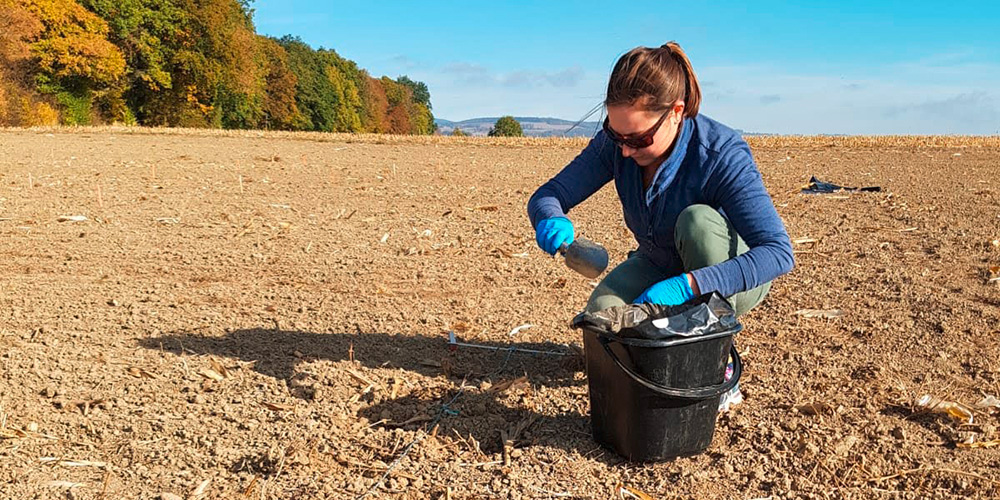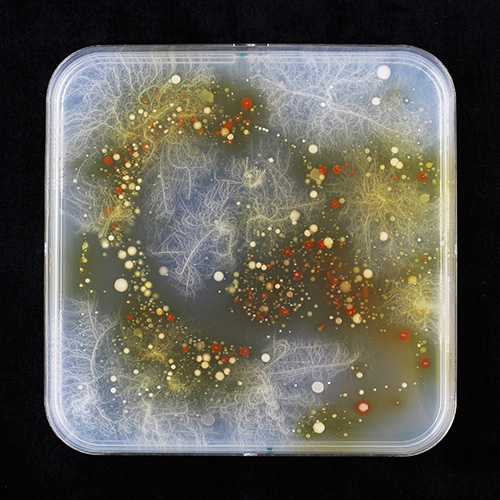Plant’s favorite bacteria to promote crop yield.
Text: Santina Russo
To optimize their growth, plants shape the bacterial community on and around their roots. Finding out how they do so is key to develop new microbiological products for greater sustainability in agriculture.
Nowadays, even a child knows that pesticides and too much fertilizer on fields are a bad thing. They lead to over-acidification of soils and bodies of water as well as posing a threat to biodiversity. That being said, these substances are also a powerful practical tool: Pesticides protect our crops from all kinds of pests, and fertilizers improve plant growth across the board — guaranteeing high yields. “The ideal thing would be a biological alternative that delivers high yields without causing environmental damage,” says Klaus Schläppi, a professor at the Department of Environmental Sciences of the University of Basel.
Today, you can already buy so-called “biologicals” for agriculture, that is products made from microorganisms: bacteria, fungi or mixes thereof that are intended to protect and nourish crops. “The problem is that these only work some of the time — but are often simply ineffective,” says Schläppi. Now, the latest analyses by his research team have revealed why this is the case and provided pointers for the development of better biologicals.
A cocktail of chemicals from the roots.
Specifically, using maize as an example, the researchers discovered that the bacterial population from agricultural soil, which accumulates on the roots, is tailored to the respective crop. Moreover, they showed that the plants control this adaptation themselves.
This is because, to some extent, plants prepare the soil in which they are growing. Through their roots, they exude a cocktail of different chemicals that influence the soil as well as the organisms within it. These chemicals include not only simple molecules such as sugars but also complex substances that vary depending on the plant. In the case of cereals such as maize and wheat, one such class of secondary plant metabolites are the benzoxazinoids. “These are released in large quantities into soil, particularly by maize plants,” says Schläppi.
The substances were already known to help plants to take up iron via their roots and to defend the plants against pests such as caterpillars and aphids. Now, Schläppi’s team has found that they actually shape the bacterial community in the soil.
Plants cultivate their favorite bacteria.
The researchers collected and characterized bacteria from maize roots and analyzed how they cope with benzoxazinoids. They found that these plant defense metabolites caused some strains of bacteria to die, while other bacteria not only tolerated these substances but could also metabolize them.
In practical terms, this was immediately apparent from the color of the respective bacterial colonies, because one of the benzoxazinoid breakdown metabolites is dark-red in color. Accordingly, bacterial strains that are capable of converting the defense metabolites can be recognized with the naked eye and targeted for further analysis. In addition, subsequent analyses showed that these bacteria can even survive with benzoxazinoids as their only source of carbon. In other words, these bacteria thrive on something that for others is a poison.
“In this way, the maize plant directly influences the microbiome living at its roots,” Schläppi explains. It cultivates its favorite bacteria, so to speak. Conversely, this means that, “where maize grows, the soil bacteria must be able to cope with the benzoxazinoids, as they’ll otherwise disappear.” This, he says, should be taken into account in the future development and use of biologicals for maize.
Personalized biologicals.
Schläppi suspects that the findings apply not only to maize but also to other crops. For example, the roots of tomato release a metabolite called alpha-tomatine, which is also known to be selective for certain species of bacteria. It would therefore be necessary to create “personalized” biologicals for the respective crops. The microorganisms of the biologicals need to be tolerant to benzoxazinoids in the case of maize and to alpha-tomatine in the case of tomatoes.
This goes beyond the realm of pure theory. In experiments with maize and wheat plants, both in the laboratory and out on the field, Schläppi’s team has investigated the effect of the benzoxazinoid-adapted bacterial community on agricultural crop rotation. The experiments did indeed show that, where maize had previously grown and left an adapted microbiome, wheat then also grew better — with no need for additional pesticides or fertilizers. The plants delivered a higher kernel yield and were better protected against pests than when the soil hadn’t been prepared by benzoxazinoid-producing maize beforehand.
Now, Schläppi wants to conduct more-detailed analyses of the bacterial community that is adapted to maize roots. “We first took apart the microbiome in order to identify the bacterial species it contained. Now we want to put it back together again piece by piece.” The aim is to find out what role the individual bacteria play regarding plant nutrition and plant protection and what happens if they are missing. Particularly useful maize bacteria could be used to develop further-improved biologicals that are adapted to maize.
Original publications:
Nature Communications (2024), doi: 10.1038/s41467-024-49643-w
PNAS (2023), doi: 10.1073/pnas.231013412
eLife (2023), doi: 10.7554/eLife.84988
More articles in this issue of UNI NOVA (November 2024).


